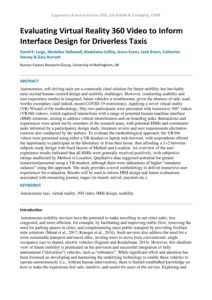| Document | Author David R. Large, Madeline Hallewell, Madelaine Coffey, Jenna Evans, Leah Briars, Catherine Harvey & Gary Burnett |
| Abstract Autonomous, self-driving taxis are a commonly cited solution for future mobility but inevitably raise myriad human-centred design and usability challenges. However, conducting usability and user experience studies in imagined, future vehicles is troublesome, given the absence of safe, road-worthy exemplars (and indeed, recent COVID-19 restrictions). Applying a novel virtual reality (VR) Wizard-of Oz methodology, fifty-two participants were presented with immersive 360° videos (VR360-videos), which captured interactions with a range of potential human-machine interface (HMI) solutions, aiming to address vehicle identification and on-boarding tasks. Interactions and experiences were acted out by members of the research team, with potential HMIs and constituent tasks informed by a participatory design study, literature review and user requirements elicitation exercise also conducted by the authors. To evaluate the methodological approach, the VR360-videos were presented using either a VR-headset or laptop web-browser, with respondents offered the opportunity to participate in the laboratory or from their home, thus affording a 2×2 between-subjects study design with fixed factors of Method and Location. An overview of the user experience results indicated that all HMIs were generally received positively, with subjective ratings unaffected by Method or Location. Qualitative data suggested potential for greater immersion/presence using a VR-headset, although there were indications of higher “simulator sickness” using this approach. The study provides a novel methodology to deliver immersive user experiences for evaluation. Results will be used to inform HMI design and future evaluations associated with remaining journey stages (in-transit, arrival, payment etc.). |

